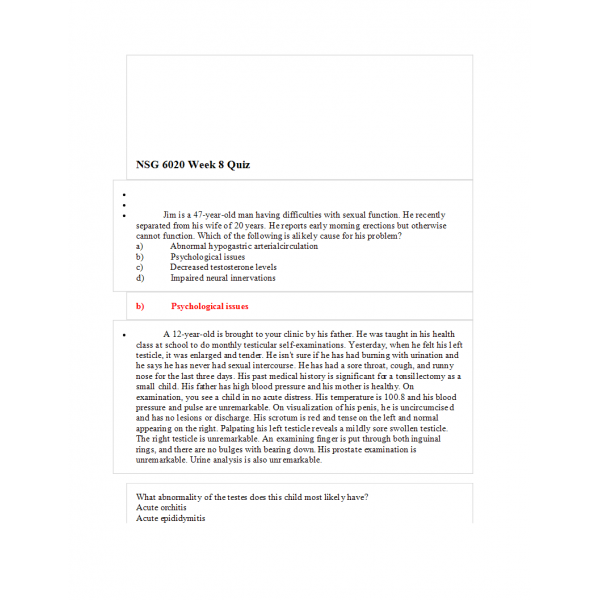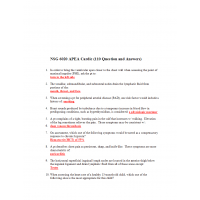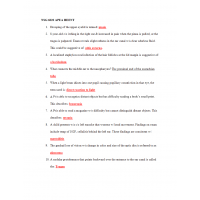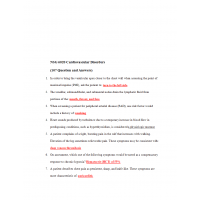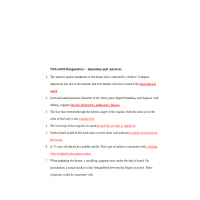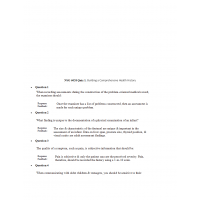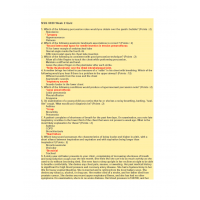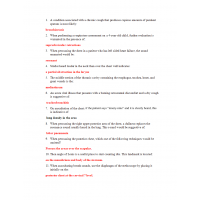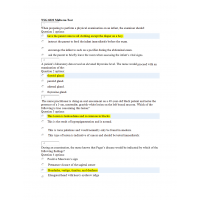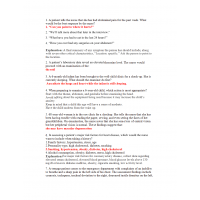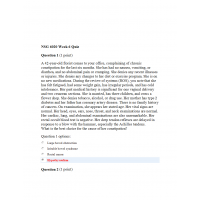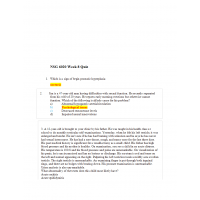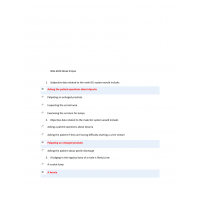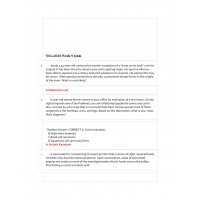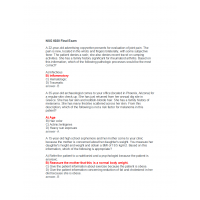NSG 6020 Week 8 Quiz with Answers
1. Jim is a 47-year-old man having difficulties with sexual function. He recently separated from his wife of 20 years. He reports early morning erections but otherwise cannot function. Which of the following is alikely cause for his problem?
2. A 12-year-old is brought to your clinic by his father. He was taught in his health class at school to do monthly testicular self-examinations. Yesterday, when he felt his left testicle, it was enlarged and tender. He isn't sure if he has had burning with urination and he says he has never had sexual intercourse. He has had a sore throat, cough, and runny nose for the last three days. His past medical history is significant for a tonsillectomy as a small child. His father has high blood pressure and his mother is healthy. On examination, you see a child in no acute distress. His temperature is 100.8 and his blood pressure and pulse are unremarkable. On visualization of his penis, he is uncircumcised and has no lesions or discharge. His scrotum is red and tense on the left and normal appearing on the right. Palpating his left testicle reveals a mildly sore swollen testicle. The right testicle is unremarkable. An examining finger is put through both inguinal rings, and there are no bulges with bearing down. His prostate examination is unremarkable. Urine analysis is also unremarkable. What abnormality of the testes does this child most likely have?
3. Important techniques in performing the rectal examination include which of the following?
4. Which of the following conditions involves a tight prepuce which, once retracted, cannot be returned?
5. 22-year-old unemployed roofer presents to your clinic, complaining of pain in his testicle and penis. He states the pain began last night and has steadily become worse. He states it hurts when he urinates and he has not attempted intercourse since the pain began. He has tried Tylenol and Ibuprofen without improvement. He denies any fever or night sweats. His past medical history is unremarkable. He has had four previous sexual partners and has had a new partner for the last month. She is on oral contraceptives, so he has not used condoms. His parents are both in good health. On examination, you see a young man lying on his side. He appears mildly ill. His temperature is 100.2 and his blood pressure, respirations, and pulse are normal. On visualization of the penis he is circumcised, with no lesions or discharge from the meatus. Visualization of the scrotal skin appears unremarkable. Palpation of the testes shows severe tenderness at the superior pole of the normal-sized left testicle. He also has tenderness when you palpate the structures superior to the testicle through the scrotal wall. The right testicle is unremarkable. An examining finger is placed through each inguinal ring without bulges being noted with bearing down. His prostate examination is unremarkable. Urine analysis shows white blood cells and bacteria. What diagnosis of the male genitalia is most likely in this case?
6. Francis is a middle-aged man who noted right sided lower abdominal pain after straining with yardwork. Which of the following findings would make a hernia a more likely diagnosis?
7. Which is the most common cause of cancer deaths in males?
8. Which of the following would lead you to suspect a hydrocele versus other causes of scrotal swelling?
9. Induration along the ventral surface of the penis suggest which of the following?
10. A 28-year old male presents with a painless, solitary chancre on the shaft of his penis and nontender inguinal lymphadenopathy. What is the most likely diagnosis? A) Chlamydia B) Gonorrhea C) Syphilis D) Herpes simplex virus (HSV) E) Human papilloma virus (HPV )
11. Frank is a 24-year-old man who presents with multiple burning erosions on the shaft of his penis and some tender inguinal adenopathy. Which of the following is most likely?
12. A 29-year-old married computer programmer comes to the clinic complaining of “something strange” going on in his scrotum. Last month while he was doing his self-testicular examination he felt a lump in his left testis. He waited a month and felt the area again but the lump was still there. He has had some aching in his left testis but denies any pain with urination or sexual intercourse. He denies any fever, malaise, or night sweats. His past medical history consists of groin surgery when he was a baby and a tonsillectomy as a teenager. He eats a healthy diet and works out at the gym five times a week. He denies any tobacco or illegal drugs and drinks alcohol occasionally. His parents are both healthy. Examination shows a muscular healthy young man with unremarkable vital signs. On visualization the penis is circumcised with no lesions; there is a scar in his right inguinal region. There is no lymphadenopathy. Palpation of his scrotum is unremarkable on the right but has a large mass on the left. While placing a finger through the inguinal ring on the right, the examiner asks the client to bear down. Nothing is felt. The examiner attempts to place a finger through the left inguinal ring but cannot get above the mass. On rectal examination the client's prostate is unremarkable. What disorder of the testes is most likely?
13. A 60-year-old security officer comes to your clinic, complaining of a painless mass in his scrotum. He found it three days ago during a testicular self-examination. He has had no burning with urination and no pain during sexual intercourse. He denies any weight loss, weight gain, fever, or night sweats. His past medical history is notable for high blood pressure. He is married and has three healthy children. He denies using illegal drugs, smokes two to three cigars a week, and drinks six to eight alcoholic beverages per week. His mother is in good health and his father had high blood pressure and coronary artery disease. On physical examination he appears anxious but in no pain. His vital signs are unremarkable. On visualization of his penis, he is circumcised and has no lesions. His inguinal region has no lymphadenopathy. Palpation of his scrotum shows a soft cystic-like lesion measuring 2 cm over his right testicle. There is no difficulty getting a gloved finger through either inguinal ring. With weight bearing, there are no bulges. His prostate examination is unremarkable. What disorder of the scrotum does he most likely have?
14. Tender painful scrotal swelling could indicate
15. Which of the following is the most important action when taking a rectal temperature using a clinical glass thermometer?
16. You are examining a newborn and note that the right testicle is not in the scrotum. What should you do next?
17. Important techniques in performing the rectal examination include which of the following? (Points : 1)
18. You are examining a newborn and note that the right testicle is not in the scrotum. What should you do next?
19. A 20-year-old part-time college student comes to your clinic, complaining of growths on his penile shaft. They have been there for about six weeks and haven't gone away. In fact, he thinks there may be more now. He denies any pain with intercourse or urination. He has had three former partners and has been with his current girlfriend for six months. He says that because she is on the pill they don't use condoms. He denies any fever, weight loss, or night sweats. His past medical history is unremarkable. In addition to college, he works part-time for his father in construction. He is engaged to be married and has no children. His father is healthy and his mother has hypothyroidism. On examination, the young man appears healthy. His vital signs are unremarkable. On visualization of his penis, you see several moist papules along all sides of his penile shaft and even two on the corona. He has been circumcised. On palpation of his inguinal region, there is no inguinal lymphadenopathy.
| Institution & Term/Date | |
| Term/Date | South University |
NSG 6020 Week 8 Quiz 1 - Question and Answers
- Product Code: 2019
- Availability: In Stock
-
$10.00
Related Products
NSG 6020 APEA Exam Cardiac
$30.00
NSG 6020 APEA Exam HEENT
$35.00

